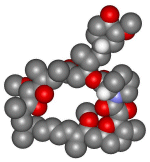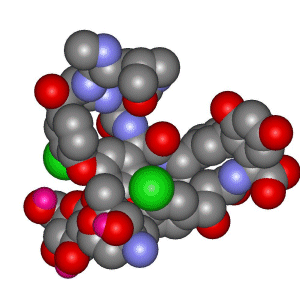Gene control
by David Bradley

While
the arguments rage over genetic engineering of organisms and the
environmental and health impact the validity of genetic modification of
food there is no doubt that gene therapy for disease will have a place
in medicine for some time to come. One of the big problems though is
controlling a gene once it has been transplanted to a patient's cells.
James Wilson and his colleagues at the University of Pennsylvania
Medical Center and Ariad Pharmaceuticals in Cambridge, Massachusetts
believe they have a simple solution that will allow patients to control
their genetic disease by popping a pill, although the process is only at
the proof of principle stage and there will be several years of safety
and clinical trials before it will be available to physicians and their
patients.
The researchers have perfected a gene delivery agent - a vector -
based on a harmless virus known as adeno-associated virus (AAV). They
splice in a replacement for a gene that is faulty or missing in a
patient with a genetic disorder into the viral genomic machinery and
simply unleash it to 'infect' the patient. That is the basic approach to
gene therapy. However, Wilson and his team have added a twist, they then
coupled this delivery method with a chemical control - the drug
rapamycin, which is usually used as an immunosuppressant in organ
transplant patients.
To test the method they spliced in the gene for the peptide hormone
erythropoietin (Epo) into AAV. Epo stimulates bone marrow to being
production of red blood cells and as a standalone 'drug' can be used to
treat certain forms of anaemia. In a second AAV vector they inserted a
transcription factor complex that regulates the gene coding for Epo.
This is the point at which the rapamycin molecule comes in to play.
Rapamycin, the Ariad scientists had discovered, switches on and off
this transcription factor, so could be used as a molecular rheostat - a
kind of dimmer switch - to control how much Epo is produced and
consequently red blood cell production.
Tests demonstrated that administering rapamycin could control the
production of Epo very precisely in laboratory animals. If the system
works in human patients it should be possible to control the activity of
a delivered gene depending on changes in a patient's symptoms - making
it almost as easy as dimming and brightening the lights.
|
|
Tubular sensor
 Pernendu
'Sandy' Dasgupta and his team at Texas Technical University (Lubbock)
and Su-Yi Liu of World Precision Instruments, in Sarasota, Florida, have
used a type of Teflon to make a new fast and inexpensive sensor for
environmentally important gases such as carbon dioxide, sulphur dioxide,
ozone and nitrogen(IV) oxide.
The material (an amorphous copolymer of perfluoro-2,2-
dimethyl-1,3-dioxole and tetrafluoroethylene is more than three times as
permeable as everyday Teflon and can be formed into 20-micrometre
diameter tubes filled with a sensitive liquid reagent. This 'chromogenic'
liquid can act as a detector for a particular compound by changing
colour on exposure to gas that enters through the permeable tube wall.
For instance, the Griess-Saltzman reagent turns purple in nitrogen(IV)
oxide. The colour change can be seen with as little as a few parts per
billion of the gas with a fast response time of less than a second.
A light emitting diode or a continuum light source acts to illuminate
the sensitive chromogenic liquid and a photodiode or charge-coupled
device spectrometer detects the colour change at the other end of the
set-up. Dasgupta points out that the basic device can be produced for
less than $100 (60 pounds) and be used to measure pollutants at ambient
levels. Moreover it can be easily adapted for different gases as well as
aqueous chlorinated hydrocarbon pollutants simply by changing the
chromogenic reagent. |
|
|
Singing fish
 An
enzyme, aromatase, converts testosterone into oestrogen in male
midshipman fish and might be responsible for turning them either into
singers who can attract a mate through their musical talents or
'sneaker' males who cannot hold a tune but horn their way in on the
mating action anyway, according to US researchers.
All vertebrates have aromatase in their brains and it is known to be
linked to the development of masculine functionality in the brain. Now a
team at Cornell University led by neurobiologist Andrew Bass [Honestly!
Ed.] working with University of California at Los Angeles (UCLA)
scientists have discovered that the adult 'sneaker' males have three to
five times more aromatase than their singing - or rather 'humming'
counterparts. Because of the enzyme's putative relationship with
masculine characteristics in the fish it might be that the enzyme could
prompt changes in the midshipman fish's brain that could make it behave
in one way or the other.
The presence of this amount of enzyme in only one type of
badly-behaving male indicates that it has at least some effect on the
development of behaviour centres and other physiological differences,
but Bass cautions that 'We have yet to prove that there is an effect on
brain development.'
The testes of sneaker males, however, occupy up to 15 percent of
their body by weight compared to only 1% for singing males - for a man
that would be over 10 kilos the pair! Although having bigger gonads does
not necessarily result in higher levels of aromatase nor vice versa.
Answering the question why might aromatase do this is still a
difficult task to be faced. The researchers think they have found the
switch but it might be triggered by any one of many different effects
such as overcrowding or other environmental factors. Perhaps, the team
speculates, the maturing male brain assesses its environment and says to
itself, 'In a sea full of singers maybe I'd be better off as a sneaker.'
Then the chemistry takes over. The existence of aromatase in the human
male's brain may have some interesting implications. Guys...do you sing
or hum? |
|
|
Beating the bugs
 A
way to make the antibiotic vancomycin, a last-line defence against
bacterial infection, has been devised by US chemists.
Kyriacos 'KC' Nicolaou and his team at The Scripps Research
Institute, La Jolla, California are famous for their solutions to the
total syntheses of complex natural products such as the anticancer
compound Taxol, the 'red-tide' poison brevetoxin and the
immunosuppressant compound rapamycin, which is also finding application
in gene therapy. Vancomycin, is the latest molecular structure to
succumb to their synthetic prowess and could be one of the most
important yet because of the recent emergence of bacterial resistance to
our shrivelling arsenal of effective antibiotics.
The ability to construct vancomycin in the laboratory means that
analogues can be made swiftly too. It is these analogues that could be
crucial in understanding how the likes of the potentially lethal 'superbug'
methicillin-resistant Staphylococcus aureus and various pathogenic
enterococci have evolved resistance. Moreover, if an analogue can be
found that beats the resistance then we will have a way to bump up the
chemical weapons against bacteria in the arsenal.
Last year, Nicolaou and Harvard's David Evans independently
approached the vancomycin molecule by building a precursor version. The
half-way house was missing its sugar branch so is known as the aglycon.
Nicolaou and his team have now found a way to add this sugar group and
have described the first total synthesis of vancomycin. |
|
|
The analytical complaints desk
 If
you have ever had trouble with your kit then you might not know you are
not alone. Forensic chemist Matthew Vona decided after one too many
equipment failures in his lab that he would do something about it, other
than simply calling in the service engineer again and again.
He and his wife, an environmental chemist set up a web site to let
analytical scientists reveal the foibles of their gear and so help
others make a more informed and objective decision when buying new
spectrometers and other machines or when signing up with an agency for a
long-term service contract.
In post-war Americana style the site has been called 'Rate-A- Vendor'
and visitors can search for messages posted about particular
instruments, which should hopefully reveal critical issues about the
worthiness of the instrument and whether or not it is worth the
thousands and sometimes millions of pounds it might cost.
The site has been running since the autumn of 1998 and is open to
bona fide analytical scientists only. Vona also points out that foul
messages or postings that are obviously libellous will not get past the
site moderator.
Issue 10 15th March 1999
|




